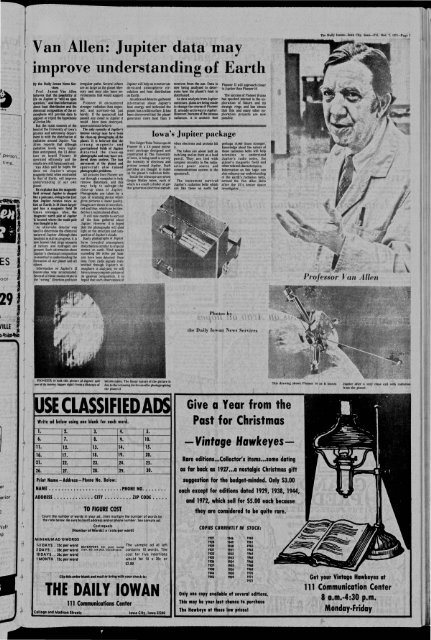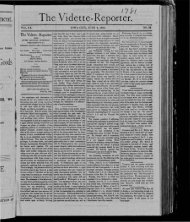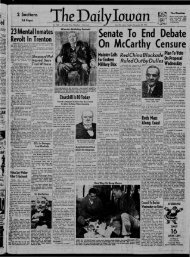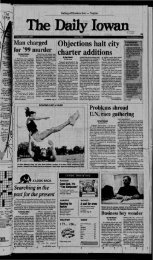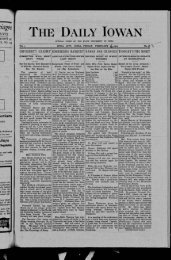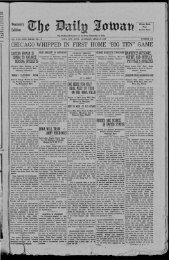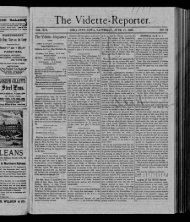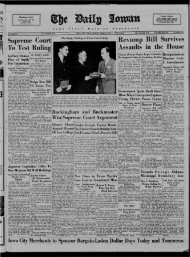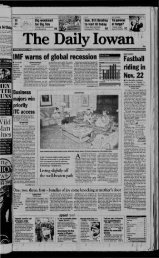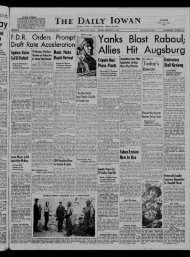Republican
December 7 - The Daily Iowan Historic Newspapers - University of ...
December 7 - The Daily Iowan Historic Newspapers - University of ...
- No tags were found...
Create successful ePaper yourself
Turn your PDF publications into a flip-book with our unique Google optimized e-Paper software.
~~B:·: __<br />
The Daily lowall-Iowa City. Iowa-Fri., Dee, 7. 19"73-Pag~ 1<br />
I Van Allen: Jupiter data may<br />
. improve understanding of Earth<br />
person<br />
time.<br />
, ..<br />
1<br />
I<br />
[<br />
v<br />
l<br />
By tbe Dally Iowan News Ser·<br />
vices<br />
Prof. James Van Allen<br />
believes that the possibility of<br />
life on Jupiter Is "still an open<br />
question, " and that information<br />
about heat distrilQlon and the<br />
chemical composition of the at·<br />
rrilsphere will provide data to<br />
support or reject the hypothesis<br />
of Jovian life.<br />
But the main concern of the<br />
head of the University of Iowa's<br />
physics and astronomy depart·<br />
ment is with the distribution of<br />
radiation around Jupiter. Van<br />
Allen reports that although<br />
radiation levels were higher<br />
than anticipated, the VI detec·<br />
tors on board Pioneer 10<br />
operated efficiently and' the<br />
results are still bein~ analyzed.<br />
Van Allen said he hopes the<br />
data on Jupiter's unique<br />
magnetic field , when contrasted<br />
to that of Earth. will improve<br />
understanding of our own<br />
planet.<br />
He explains tbat tbe magnetic<br />
field around Jupiter is shaped<br />
like a pancake, owing to the fact<br />
that Jupiter rotates twice as<br />
fast as Eartb, is 10 times larger<br />
and has a magnetic field 30<br />
times stro1lger, MilO, the<br />
magnetic north pole of Jupiter<br />
Is located where the south pole<br />
was thought to be.<br />
An ultraviolet detector was<br />
used to determine the chemica[<br />
nature of Jupiter. Although data<br />
analysis is still in progress. it is<br />
now known that large amounts<br />
of helium and hydrogen are<br />
present. Such information about<br />
Jupiter'S chemical composition<br />
is essential to understanding the<br />
formation of our planet and all<br />
others.<br />
Information on Jupiter's 12<br />
moons also was accumulated.<br />
Several of these moons rotate in<br />
the "wrong" direction and have<br />
irregular paths. Several others<br />
are as large .as the planet Mer·<br />
cury and may also have environments<br />
that would support<br />
life.<br />
Pioneer 10 encountered<br />
stronger radiation than expected,<br />
and survived-but just<br />
barely. If the spacecraft had<br />
passed any closer to Jupiter it<br />
space would scientists have been believe. destroyed.<br />
The only casualty of Jupiter's I<br />
Intense energy may have been<br />
the close-up photographs of the<br />
planet. It Is believed that the<br />
strong magnetic and<br />
gravitational fields of Jupiter<br />
distorted the close·up<br />
photographs and may have rendered<br />
them useless. The fast<br />
movement of the planet and<br />
spacecraft also caused<br />
photographic problems,<br />
All pictures from Pioneer are<br />
run through a computer to help<br />
remove distortions, and this<br />
rna y help to sal vage the<br />
close-up shots of Jupiter.<br />
Photographs are taken by a<br />
type of scanning device which<br />
gives pictures a linear quality.<br />
Images are shown in two colors.<br />
red and blue. which can be blended<br />
lor a mu\tico\ored el!ect.<br />
It will take months to sort out<br />
all the data gathered a bout<br />
Jupiter. However, it is hoped<br />
that the photographs will shed<br />
light on the structure and composition<br />
of Jupiter's clouds.<br />
Early photographs of Jupiter<br />
have revealed atmospheric<br />
disturbances similar to tropical<br />
storms on earth. Wind speeds<br />
exceeding 200 miles per hour<br />
also have been detected. Once<br />
data from radio signals transmitted<br />
through Jupiter's atmosphere<br />
is analyzed, we wi II<br />
have a more complete picture of<br />
its gaseous composition. It is<br />
hoped that such observations of<br />
receives from the sun. Data is Pioneer II will approach closer<br />
now being analyzed to determine<br />
how the planet's heat is<br />
to Jupiter than Pioneer 10.<br />
distributed.<br />
The success of Pioneer 10 also<br />
As data analysis from Jupiter has sparked interest in the ex·<br />
continues, plans are being made ploration of Saturn and its<br />
to change the course of Pioneer strange rings and has shown<br />
II, already on its way to Jupiter. that this and many other exploration<br />
projects are now<br />
However, because of the intense<br />
radiation, it is unlikelv that possible.<br />
·.!.· .nl ________________________<br />
Jupiter will help us to better understand<br />
atmospheric circulation<br />
and heat distribution<br />
on Earth.<br />
An infrared detector gathered<br />
information about Jupiter's<br />
heat energy and indicated the<br />
planet has a solid surface. It has<br />
been discovered that the planet<br />
generates more heat than it<br />
The Geiger Tube Telescope on<br />
Pioneer 10, a 3.6 pound instrument<br />
package designed and<br />
constructed at The University<br />
of Iowa , is being used to survey<br />
the intensity of electrons and<br />
protons around Jupiter. Such<br />
particles are thought to make<br />
up the planet's radiation belts.<br />
Inside the telescope are se'ven<br />
Geiger Muller tubes, each of<br />
which is a small cylinder of gas<br />
that generates electrical si~nals<br />
Iowa's Jupiter package<br />
when electrons and protons hit<br />
it.<br />
The tubes are about half an<br />
inch long and as thick as a lead<br />
pencil. They are tied with<br />
complex circuitry to the radio·<br />
active power source and<br />
communications system in the<br />
spacecraft.<br />
The instrument survived<br />
Jupiter's radiation belts which<br />
are like those on earth but<br />
perhaps 10,000 times stronger.<br />
Knowledge about the nature of<br />
these radiation belts will help<br />
scientists to understand<br />
Jupiter'S radio noise, the<br />
planet's magnetic field and<br />
other related characteristics.<br />
Information on this topic can<br />
also enhance our understanding<br />
of the earth's radiation belts,<br />
termed the Van Allen Belts<br />
after the UI's senior space<br />
investigator.<br />
Professor Vall Allen<br />
..<br />
Photos by<br />
the Daily Iowan News Services<br />
f<br />
j<br />
PIONEER 10 look this picture of Jupiter and<br />
olle of its moons (upper right) from a distance of<br />
000,000 miles. The linear nature of the picture is<br />
due to the scanning device used in photographing<br />
the planet.$<br />
This drawing shows Pioneer 10 as It leaves<br />
Jupiter aller a very clo e call with radiation<br />
rrom the planet.<br />
USE CLASSIFIED A<br />
Write ad below using one blank for each word •<br />
•<br />
1. 2. 3. 4. 5.<br />
6. 7. 8. 9. 10.<br />
11. 12. 13. 14. 15.<br />
Give a Year from the<br />
Past for Christmas<br />
- Vintage Hawlceyes-<br />
er<br />
rior<br />
Volt<br />
P<br />
I.<br />
I.<br />
,<br />
, l. ,<br />
16. 17. 18. 19. 20.<br />
21. 22. 23. 24. 25.<br />
26. 27. 28. 29. 30.<br />
Print Name - Address - Phone No. aelow:<br />
NAME •••••••••••••••••••••••• PHONE NO ••• . . . . .<br />
ADDRESS ••• ....•••••• CITY •.' ••••••• ZIP CODE •<br />
TO FIGURE COST<br />
Count the number of words In your ad ... then multiply the number of words by<br />
the rate below. Be sure to count address and·or phone number. See sample ad.<br />
MINIMUM AD 10WORDS<br />
1·3 DA YS .. 2Sc per word<br />
5 DA YS , . , .21c per word<br />
10 DA YS . , ,36c per word<br />
1 MONTH . 7Sc per word<br />
Cost equals<br />
(Number of W rds) x (rate per word)<br />
DAVENPORT, $50; green lounge The ~ample ad at left<br />
chair, $30; oak desk. Dial 338-xxxx. conta Ins 10 words. The<br />
cost for five insertions<br />
would be 10 x 28c or<br />
$2.80.<br />
Clip tills order bI.nk .nd m.1I or bring with your check to:<br />
'HE ,DAILY IOWAN<br />
111 Communications Center<br />
College and Madison Streets Iowa City, Iowa 52240<br />
. Rare editions ... Coliector's items ••• some dating<br />
as far back as 1927 ••• a nostalgic Christmas gift<br />
suggestion for the budget-minded. Only $3.00<br />
each except for editions dated 1929, 1938, 1944,<br />
and 1972, which sell for $5.00 each because<br />
they are considered to be quite rare.<br />
COPIES CURRENny IN STOCIC:<br />
1927<br />
1921<br />
1929<br />
1931<br />
1933<br />
1935<br />
1936<br />
1937<br />
1931<br />
1944<br />
1945<br />
1946<br />
1949<br />
1950<br />
1951<br />
1952<br />
1953<br />
1954<br />
1955<br />
1956<br />
1951<br />
1959<br />
1960<br />
1961<br />
J962<br />
1963<br />
1964<br />
1965<br />
1966<br />
1961<br />
1969<br />
1970<br />
1971<br />
1972<br />
Onl, on. copy avallabl. of ."aral editions.<br />
Thi. ma, b. your la.t chance to purchase<br />
Tha Hawkey. at th ••• low prlcell<br />
Get your Vintage Hawkeyes at<br />
111 Communication Center<br />
8 a.m.·4:30 p.m.<br />
Monday-Friday


